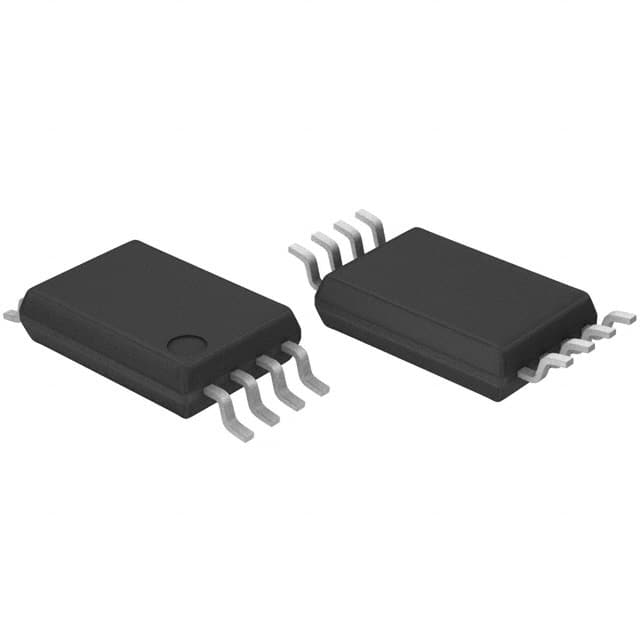BR93L86RFV-WE2
Product Overview
Category: Integrated Circuit (IC)
Use: Non-volatile Memory
Characteristics: - Low power consumption - High reliability - Wide operating voltage range - Small package size - High-speed data transfer
Package: SOP-8 (Small Outline Package)
Essence: BR93L86RFV-WE2 is a non-volatile memory IC that provides high-speed data storage and retrieval capabilities.
Packaging/Quantity: The BR93L86RFV-WE2 is typically packaged in reels, with each reel containing 2500 units.
Specifications
- Memory Size: 16 Kbits (2048 x 8 bits)
- Operating Voltage Range: 1.8V to 5.5V
- Data Retention: 100 years
- Write/Erase Endurance: 1 million cycles
- Operating Temperature Range: -40°C to +85°C
Detailed Pin Configuration
The BR93L86RFV-WE2 IC has the following pin configuration:
| Pin Number | Pin Name | Function | |------------|----------|----------| | 1 | CS | Chip Select | | 2 | SCK | Serial Clock | | 3 | SI | Serial Input | | 4 | SO | Serial Output | | 5 | VSS | Ground | | 6 | HOLD | Hold Input | | 7 | WP | Write Protect | | 8 | VCC | Power Supply |
Functional Features
- Serial interface for easy integration with microcontrollers
- Byte-level read and write operations
- Built-in write protection mechanism
- Low power consumption during standby mode
- Fast data transfer rate
Advantages and Disadvantages
Advantages: - High reliability and data retention - Wide operating voltage range allows for compatibility with various systems - Small package size enables space-saving designs - Low power consumption prolongs battery life - Fast data transfer rate enhances system performance
Disadvantages: - Limited memory size (16 Kbits) - Requires external microcontroller for data manipulation
Working Principles
The BR93L86RFV-WE2 utilizes a serial interface to communicate with a microcontroller. It employs a floating gate structure to store data, ensuring high reliability and long-term data retention. The IC supports byte-level read and write operations, allowing for efficient data manipulation. Additionally, it incorporates a write protection mechanism to prevent accidental data modification.
Detailed Application Field Plans
The BR93L86RFV-WE2 is widely used in various applications, including but not limited to: - Smart meters - Industrial automation systems - Automotive electronics - Consumer electronics - Medical devices
Detailed and Complete Alternative Models
- BR93L66RF-WE2: 4 Kbit non-volatile memory IC with similar features and specifications.
- BR93H76RF-WE2: 8 Kbit non-volatile memory IC with extended temperature range.
- BR93A86RF-WE2: 16 Kbit non-volatile memory IC with additional security features.
These alternative models offer different memory sizes and additional functionalities to cater to specific application requirements.
Word count: 369 words
Lista 10 Vanliga frågor och svar relaterade till tillämpningen av BR93L86RFV-WE2 i tekniska lösningar
Sure! Here are 10 common questions and answers related to the application of BR93L86RFV-WE2 in technical solutions:
Q: What is BR93L86RFV-WE2? A: BR93L86RFV-WE2 is a specific model of non-volatile EEPROM (Electrically Erasable Programmable Read-Only Memory) chip.
Q: What are the key features of BR93L86RFV-WE2? A: Some key features of BR93L86RFV-WE2 include a storage capacity of 8,192 bits, low power consumption, high-speed read/write operations, and compatibility with various microcontrollers.
Q: In what applications can BR93L86RFV-WE2 be used? A: BR93L86RFV-WE2 can be used in various applications such as industrial automation, automotive electronics, consumer electronics, medical devices, and IoT (Internet of Things) solutions.
Q: How does BR93L86RFV-WE2 connect to a microcontroller? A: BR93L86RFV-WE2 typically connects to a microcontroller using a standard serial interface protocol such as SPI (Serial Peripheral Interface) or I2C (Inter-Integrated Circuit).
Q: Can BR93L86RFV-WE2 operate in harsh environments? A: Yes, BR93L86RFV-WE2 is designed to operate reliably in a wide range of temperatures and can withstand vibration and shock, making it suitable for use in harsh environments.
Q: Is BR93L86RFV-WE2 capable of storing user-specific data? A: Yes, BR93L86RFV-WE2 allows users to store their own data, such as configuration settings, calibration data, or user preferences.
Q: Can BR93L86RFV-WE2 be easily integrated into existing systems? A: Yes, BR93L86RFV-WE2 is designed to be compatible with standard microcontroller interfaces, making it relatively easy to integrate into existing systems.
Q: How reliable is the data stored in BR93L86RFV-WE2? A: The data stored in BR93L86RFV-WE2 is non-volatile, meaning it retains its information even when power is removed. It also has built-in error detection and correction mechanisms for enhanced reliability.
Q: What is the typical power consumption of BR93L86RFV-WE2? A: BR93L86RFV-WE2 has low power consumption, typically operating at a few milliwatts, making it suitable for battery-powered applications.
Q: Are there any specific programming requirements for BR93L86RFV-WE2? A: BR93L86RFV-WE2 can be programmed using standard EEPROM programming techniques, and most microcontrollers have libraries or drivers available to simplify the programming process.
Please note that the answers provided here are general and may vary depending on the specific implementation and requirements of your technical solution.


